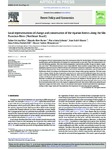Por favor, use este identificador para citar o enlazar este ítem:
http://www.alice.cnptia.embrapa.br/alice/handle/doc/987548Registro completo de metadatos
| Campo DC | Valor | Lengua/Idioma |
|---|---|---|
| dc.contributor.author | SILVA, T. C. | pt_BR |
| dc.contributor.author | RAMOS, M. A. | pt_BR |
| dc.contributor.author | SCHWARZ, M. L. | pt_BR |
| dc.contributor.author | ALVAREZ, I. A. | pt_BR |
| dc.contributor.author | KIILL, L. H. P. | pt_BR |
| dc.contributor.author | ALBUQUERQUE, U. P. | pt_BR |
| dc.date.accessioned | 2014-06-03T11:11:11Z | pt_BR |
| dc.date.available | 2014-06-03T11:11:11Z | pt_BR |
| dc.date.created | 2014-06-03 | pt_BR |
| dc.date.issued | 2014 | pt_BR |
| dc.identifier.citation | Forest Policy and Economics, v. 43, p. 1-12, 2014. | pt_BR |
| dc.identifier.uri | http://www.alice.cnptia.embrapa.br/alice/handle/doc/987548 | pt_BR |
| dc.description | Investigations of local representations about the environment allow for the elucidation of historical landscape transformation and the elaboration of strategies for environmental conservation. Thus, this study aimed to answer the following questions. How does the local population represent the possible changes in riparian vegetation over time? What historical events were responsible for these possible changes? How does the local population represent concerns related to the use andmaintenance of riparian vegetation? This study was carried out with 87 informants from three communities: two rural ex-settlement communities and one quilombo in Northeastern Brazil. According to the informants, therewere changes in the riparian vegetation. Themain causes of these changes include the type of agriculture practiced in the region and the building of a large dam to provide water to the city of Sobradinho in the state of Bahia. However, there was no significant difference between the number of informants who said that the changes were for the worse and those who said that they were for the better. In addition, the respondents reported an increase in the abundance of exotic species and a decrease in the abundance of native species. Thus, the importance of including this group of people in the process of the forest restoration that will occur in the region is emphasized because they possess information about the past vegetation changes and their causes. They can also indicatewhich species should be prioritized for replanting according to their usage needs and they understand the importance of conserving riparian vegetation. | pt_BR |
| dc.language.iso | eng | eng |
| dc.rights | openAccess | eng |
| dc.subject | Representação local | pt_BR |
| dc.subject | Rio São Francisco | pt_BR |
| dc.subject | Percepção ambiental | pt_BR |
| dc.subject | Modificação da paisagem | pt_BR |
| dc.subject | Vegetação ripária | pt_BR |
| dc.subject | Natural resource | pt_BR |
| dc.title | Local representations of change and conservation of the riparian forests along the São Francisco River (Northeast Brazil). | pt_BR |
| dc.type | Artigo de periódico | pt_BR |
| dc.date.updated | 2014-06-03T11:11:11Z | pt_BR |
| dc.subject.thesagro | Recurso natural | pt_BR |
| dc.subject.thesagro | Vegetação | pt_BR |
| dc.subject.thesagro | Conservação | pt_BR |
| dc.subject.thesagro | Mata Ciliar | pt_BR |
| riaa.ainfo.id | 987548 | pt_BR |
| riaa.ainfo.lastupdate | 2014-06-03 | pt_BR |
| dc.identifier.doi | 10.1016/j.forpol.2013.11.007 | pt_BR |
| dc.contributor.institution | TALINE CRISTINA SILVA, UFRPE; MARCELO ALVES RAMOS, UPE; MARIA LUIZA SCHWARZ, UFCG; IVAN ANDRE ALVAREZ, CNPM; LUCIA HELENA PIEDADE KIILL, CPATSA; ULYSSES PAULINO ALBUQUERQUE, UFRPE. | pt_BR |
| Aparece en las colecciones: | Artigo em periódico indexado (CPATSA)  | |
Ficheros en este ítem:
| Fichero | Descripción | Tamaño | Formato | |
|---|---|---|---|---|
| kIILL2014.pdf | 1,72 MB | Adobe PDF |  Visualizar/Abrir |









